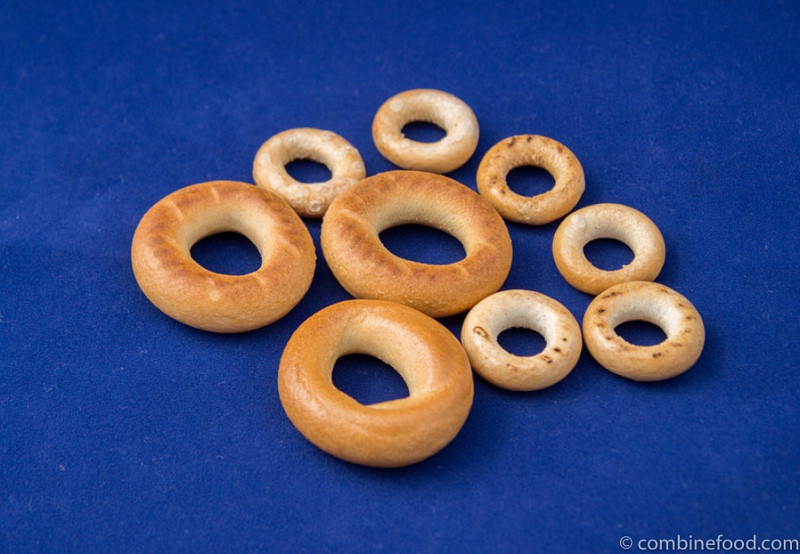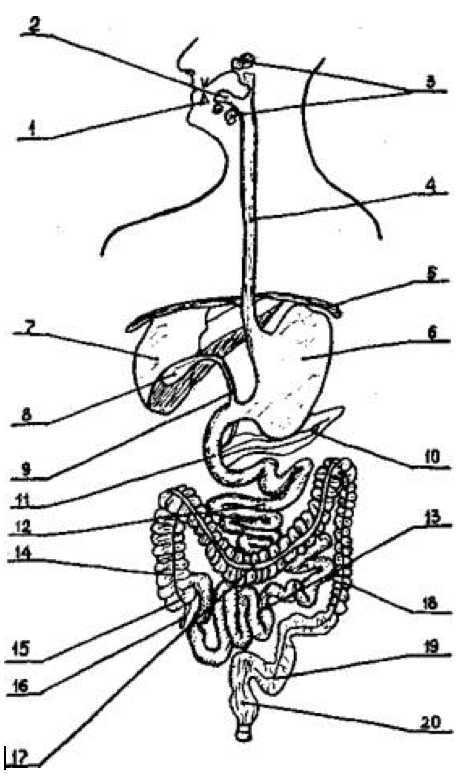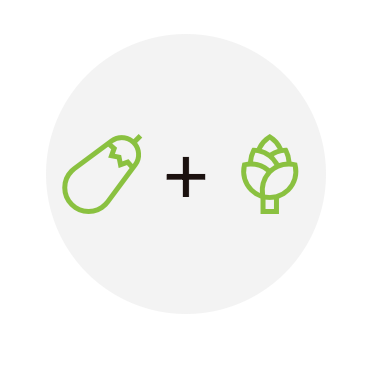
Wouldn’t it be nice to know something about our digestive system and about what happens to food “when it gets inside”?
A person who can cook well, but does not know what happens to his dishes after they are eaten is like a driver who learned the traffic regulations and how to control his car, but has no idea of how a car works. It’s quite risky to set out for a long journey with such limited knowledge, even if the car is good, because various unexpected things can happen on the way. Let’s look at the general structure of the digestive system.
DIGESTIVE SYSTEM STRUCTURE
So, let’s examine the scheme shown in figure 1. We just took a bite off some piece of food. We bit it with our teeth (1) and we are continuing to chew with them as well.
Even this purely physical breakdown plays a very important role as the food should enter our stomach in the form of a slurry, because if it stays in pieces it is digested tens and even hundreds of times worse. Those doubting the significance of teeth can try to eat something without biting and chewing it.
In this process food is also soaked in saliva secreted by the three pairs of major salivary glands (3) and many minor ones. In 24 hours from 0.5 to 2 liters of saliva are normally produced. The enzymes contained in saliva mostly break down starch. Due to chewing a homogeneous liquid mass is formed which will not require much more effort for further digestion.
Apart from its chemical influence on food, saliva possesses antiseptic properties. Even when you are not eating, it is always watering your oral cavity, protecting the oral mucosa from becoming too dry and helping to disinfect it. That is why when you get a scratch, the first thing you want to do is to lick it. Of course saliva is not as effective in disinfection as hydrogen peroxide or iodine, but then it is always within easy reach.
Finally, our tongue (2) accurately defines if the food is tasty or not, sweet or bitter, salty or sour. These signals serve as an indication of which juices and how much of them is necessary for digestion. Chewed food passes through the pharynx and goes into the esophagus (4). Swallowing is quite a complex process, there many muscles taking part in it and it mostly happens instinctively.
The esophagus is a four-layer muscular tube 22 to 30 cm long. When relaxed it looks like a hole, but everything that you eat or drink does not just fall down, but is moved via rhythmic wave-like contractions of its walls. During all this time salivary digestion is actively continued.
The rest of digestive organs are located in the abdomen. They are separated from the thorax by the diaphragm (5) – the main muscle responsible for our breathing process. There is a special aperture in the diaphragm through which the esophagus passes into the abdominal cavity and empties into the stomach (6).
The shape of this hollow organ resembles that of a retort. Its inner mucous surface has several folds. The volume of a completely empty stomach is around 50 ml, but in the process of eating it stretches and can store quite a lot – up to 3-4 liters.
Continuing, the food we swallow gets inside the stomach. Its further transformations are defined mostly by its structure and amount. Glucose, alcohol, salts and excess of water can be absorbed immediately depending on their concentration and combination with other products. Most of the remaining things we eat are subject to gastric juices. These juices contain hydrochloric acid, some enzymes and mucus. They are produced by special glands in the gastric mucosa, the number of which goes up to 35 million. The composition of gastric juice constantly changes depending on the type of food you are eating.
It is interesting that the stomach seems to know in advance what kind of food it is going to deal with and that it produces the necessary type of juice sometimes a long time before eating – just based on the sight or smell of food. This was proved by the professor Ivan Pavlov during his famous experiments on digestion in dogs. For a human to start producing gastric juices, it is enough just to have a clear thought of food.
Figure 1

1 – teeth, 2 – tongue, 3 – salivary glands, 4 – esophagus, 5 – diaphragm, 6 – stomach, 7 – liver, 8 – gallbladder, 9 – common bile duct, 10 – pancreas, 11 – duodenum, 12 – jejunum, 13 – ileum, 14 – ascending colon, 15 – cecum, 16 – appendix, 17 – transverse colon, 18 – descending colon, 19 – sigmoid colon, 20 – rectum.
Digestion of fruits, soured milk and other light products requires a small quantity of gastric juice with lower acidity and fewer enzymes, while meat, especially when it is spicy, causes production of a much more concentrated gastric juice in bigger quantities. The gastric juice necessary to digest bread has mild acidity, but is very rich in enzymes. During a day, an average of 2 – 2.5 liters of gastric juice is produced.
An empty stomach often contracts (Its lower part bordering with the pylorus is the one that contracts the most. ). This process is known to everyone who has already experienced the so called hunger pains. When you eat something, these movements stop. That is an important fact. Consumed food spreads around the inner surface of the stomach. Portions of food in the stomach stay in the shape of a cone enclosed in the previous layers of food.
Gastric juice mostly affects the surface layers of food, those that are in contact with the gastric mucosa. Meanwhile, the bulk part continues to suffer the action of the salivary enzymes for a long time.
Enzymes are protein-like substances responsible for catalyzing different chemical reactions. The main enzyme contained in gastric juice is called pepsin and its function is to break proteins down. As the portions of food located closer to the stomach walls are digested, they start moving towards the exit – the pylorus. By that time the stomach’s motor function is restored and due to its periodic contractions food is thoroughly mixed. As a result of this process, when food reaches the duodenum it looks like a homogeneous half-digested mixture.
The pylorus “guards” the entrance to the duodenum. It is a muscular valve that lets the food mass flow in only one direction.
The duodenum is a part of the small intestine. In general, the whole gastrointestinal tract starting from the throat and ending in the rectum resembles a single tube that has various expansions and thickenings (even such big ones as the stomach), different bends, loops and a couple of sphincters (valves). But separate parts of this tube are differentiated based on their anatomic qualities and digestive functions. That’s why the small intestine is commonly divided into three parts: the duodenum (11), the jejunum (12) and the ileum (13).
The duodenum is the thickest one, but its length is just 25 to 30 cm. Its inner surface is covered by innumerous intestinal villi and there are small glands in its submucosa, secretion of which helps further disintegration of proteins and carbohydrates.
The pancreatic duct and common bile duct enter the descending duodenum. The common bile duct supplies bile produced by the biggest gland in our body – the liver (7). In a day the liver produces up to one liter of bile, which is quite an impressive number. The bile consists of water, fatty acids, cholesterol and inorganic substances.
Production of bile starts in 5-10 minutes after you start eating and stops when the last portion of food leaves your stomach.
Bile completely neutralizes the effect of gastric juice and due to that gastric digestion gives place to intestinal digestion. Bile also emulsifies fats. Emulsification increases the surface area of fat, significantly expanding its contact with digestive enzymes. Bile’s functions also include improvement of absorption of products of fat digestion and other nutrient substances – such as amino acids and vitamins, and also to contribute to the movement of food and to prevent it from rotting.
Bile is stored in the gallbladder (8). Its volume is around 40 ml, but the bile stored there is concentrated, so it is 3-5 times thicker than the liver bile. When necessary it comes through the cystic duct, which is connected with the hepatic duct. They form the common bile duct (9) that delivers bile to the duodenum.
The pancreatic duct starting in the pancreas (10) also ends in the duodenum. The pancreas is the second biggest gland in the human body. Its length can reach 15 to 22 cm and its weight can range from 60 to 100 grams.
Technically speaking, the pancreas consists of two glands – exocrine, producing up to 500-700 mL of pancreatic juice per day, and endocrine, producing hormones. The difference between those two glands is that the exocrine glands secrete substances onto the epithelial surface, in this case into the duodenum, while endocrine glands secrete their products, hormones, directly into the blood or lymph.
The pancreatic juice contains a complex set of enzymes breaking down all food constituents – proteins, fats and carbohydrates. This juice is produced every time the stomach contracts from hunger and its permanent production starts in a couple of minutes after you start eating. The composition of juice changes depending on the type of food.
The hormones produced in the pancreas – insulin, glucagon and others – regulate carbohydrate and fat metabolism. Insulin, for example, stops decay of glycogen (animal starch) in the liver and increases the rate of glucose uptake by most body cells. During this process, the level of sugar in blood goes down.
But let’s go back to the food transformation process. In the duodenum food is mixed with bile and pancreatic juice. Bile stops the effect of stomach enzymes and regulates functioning of the pancreatic juice. Proteins, fats and carbohydrates continue decomposing. Excesses of water, mineral salts, vitamins and completely digested substances are absorbed through the intestinal walls.
After taking a sharp bend the duodenum turns into the jejunum (12) that is normally 2 to 2.5 meters long. The latter is connected to the ileum (13) which is around 2.5 to 3.5 meters long. Therefore, the total length of the small intestine is around 5-6 meters. Its absorption abilities are multiplied because of the amount of circular folds, which can reach up to 600-650. Moreover the inner surface of the small intestine is covered by innumerous villi. Their coordinated movements ensure the progression of food and they also absorb nutrients.
Scientists used to think that the intestinal absorption was a purely mechanical process. It was supposed that the nutrient substances were decomposed inside the intestine till the state of elementary particles that were later absorbed into the blood through the intestinal walls.
But it turned out that the constituents of food do not completely decompose inside the intestine, their final decomposition occurs only near the walls of intestinal cells. This process is called parietal digestion.
How does it work? Nutrients that were already significantly grinded by the effect of pancreatic juice and bile in the intestine pass through the villi of intestinal cells. The villi form such a thick cover that it makes the intestinal surface unavailable for bigger molecules, especially for bacteria. Intestinal cells secrete various enzymes into this sterile zone and the nutrients are divided into basic components – amino acids, fatty acids, simple sugars, which are then absorbed. Decomposition and absorption occur in a very limited space and are often united in one complex and interconnected process.
One way or another during its way through the five meters of small intestine the food is completely digested and the substances received are absorbed into blood. But they do not come directly into the general bloodstream. If that would happen, a person could die after any single meal.
All the blood from the stomach and the intestine comes to the portal vein that delivers it to the liver. The food does not contain only useful substances. In the process of its digestion many by-products are formed. There are also various toxins released by the intestinal microflora and different medicals and poisons contained in products (especially considering current ecological situation). And even purely nutrient substances should not go directly to the general bloodstream; otherwise their concentration in blood would be too high.
All those problems are resolved by the liver. It is not in vain that the liver is called the main chemical laboratory in the human body. The liver is responsible for detoxification of harmful compounds and regulation of protein, fat and carbohydrate metabolism. All these substances can be synthesized and decomposed in the liver depending on the necessities of the body, what ensures the stability of our internal environment.
The intensiveness of liver’s work can be demonstrated by the fact that, despite weighing just 1.5 kilograms, the liver consumes one seventh of all the energy produced in the human body. In just one minute the liver filters around 1.5 liters of blood, and its vessels can contain up to 20% of the total amount of blood in the human body.
But let’s continue following the route of food in our body. From the ileum through a special valve, preventing the food from coming back, the undigested remains come to the large intestine. Its total length ranges from 1.5 to 2 meters. Anatomically speaking, it consists of the cecum (15), the appendix (16), the transverse colon (17), the descending colon (18), the sigmoid colon (19) and the rectum (20).
In the large intestine the absorption of water is completed and feces are formed. For this purpose the intestinal cells secrete special mucus.
There are myriads of microorganisms living in the large intestine. One third of feces is composed by bacteria. That does not mean it is something bad. Due to this a special symbiosis between the “host” and its “guests”, that is, the body and the bacteria is formed. Those microorganisms feed on the body waste and produce vitamins, some enzymes, amino acids and other useful substances. Moreover, permanent presence of microbes maintains the efficiency of our immune system, as it does not let it stay without work. And those bacteria that permanently live in our bodies also do not let some strange bacteria, especially pathogenic ones, get in.
But everything happens in this ideal way only when a person eats correctly. Unnatural, refined products, excess of food and wrong combinations of products change the composition of microflora. Putrefactive bacteria start prevailing and instead of vitamins a person receives poison. Various medicines, especially antibiotics, also significantly damage our microflora.
But in any case feces continue moving because of wave-like contractions of the intestine, called peristalsis, and reach the rectum. There are two sphincters located in the end of the rectum, internal and external, that open just for defecation. In the case of normal alimentation around 4 kilograms of food mass per day come from the small intestine into the large one, but there is just around 150-250 grams of feces formed. Vegetarians form much more feces, because their food contains a lot of cellulose. But then their intestine works perfectly, their microflora is quite favorable, and poisonous products mostly do not even reach liver, as they are absorbed by cellulose, pectin and other fibers.
At this point we will stop our overview of the digestive system. It is worth saying that its role goes far beyond purely digestive functions. Everything in our body is interconnected and interdependent both on physical and emotional levels. For example, it was recently discovered that the intestine is also a very powerful hormone producing machine. The volume of substances synthesized in it is almost the same (!) as that of all the endocrine glands combined.
Text: from the book of A Eddar "The treatise of nutrition".


 en
en  ru
ru 
















Combinefood
Your comment has been sent for moderation!
Next